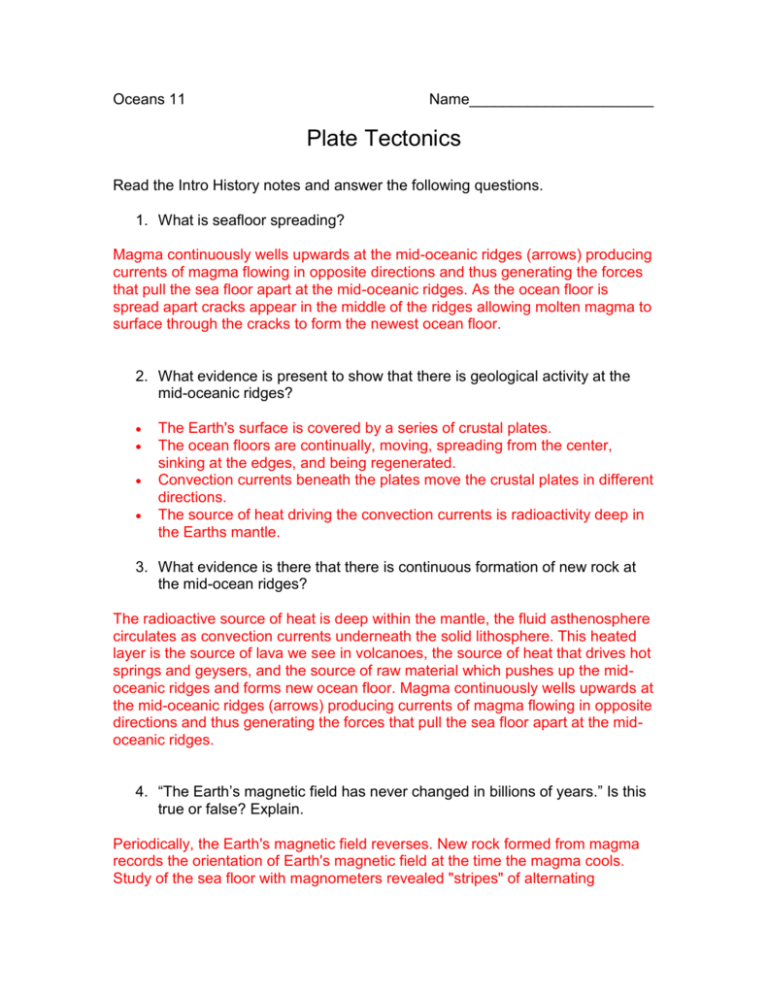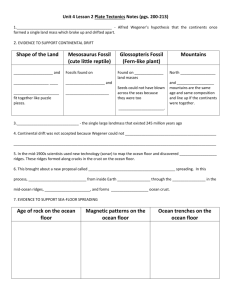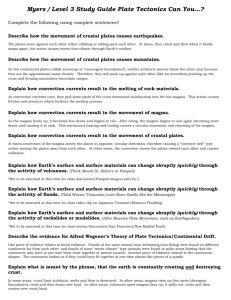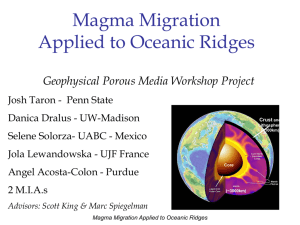PTMechanism answers
advertisement

Oceans 11 Name______________________ Plate Tectonics Read the Intro History notes and answer the following questions. 1. What is seafloor spreading? Magma continuously wells upwards at the mid-oceanic ridges (arrows) producing currents of magma flowing in opposite directions and thus generating the forces that pull the sea floor apart at the mid-oceanic ridges. As the ocean floor is spread apart cracks appear in the middle of the ridges allowing molten magma to surface through the cracks to form the newest ocean floor. 2. What evidence is present to show that there is geological activity at the mid-oceanic ridges? The Earth's surface is covered by a series of crustal plates. The ocean floors are continually, moving, spreading from the center, sinking at the edges, and being regenerated. Convection currents beneath the plates move the crustal plates in different directions. The source of heat driving the convection currents is radioactivity deep in the Earths mantle. 3. What evidence is there that there is continuous formation of new rock at the mid-ocean ridges? The radioactive source of heat is deep within the mantle, the fluid asthenosphere circulates as convection currents underneath the solid lithosphere. This heated layer is the source of lava we see in volcanoes, the source of heat that drives hot springs and geysers, and the source of raw material which pushes up the midoceanic ridges and forms new ocean floor. Magma continuously wells upwards at the mid-oceanic ridges (arrows) producing currents of magma flowing in opposite directions and thus generating the forces that pull the sea floor apart at the midoceanic ridges. 4. “The Earth’s magnetic field has never changed in billions of years.” Is this true or false? Explain. Periodically, the Earth's magnetic field reverses. New rock formed from magma records the orientation of Earth's magnetic field at the time the magma cools. Study of the sea floor with magnometers revealed "stripes" of alternating magnetization parallel to the mid- continuous formation of new rock at the ridges. As more rock forms, older rock is pushed farther away from the ridge, producing symmetrical stripes to either side of the ridge. 5. Where is the oldest seafloor found? How deep is this area? The mid-oceanic ridges rise 3000 meters from the ocean floor and are more than 2000 kilometers wide surpassing the Himalayas in size. The mapping of the seafloor also revealed that these huge underwater mountain ranges have a deep trench which bisects the length of the ridges and in places is more than 2000 meters deep. 6. What are Island Arcs? What do they tell us about the asthenosphere located beneath the plates? Chains of islands are found throughout the oceans and especially in the western Pacific margins; the Aleutians, Kuriles, Japan, Ryukus, Philippines, Marianas, Indonesia, Solomons, New Hebrides, and the Tongas, are some examples... These "Island arcs" are usually situated along deep sea trenches and are situated on the continental side of the trench. They support the theory that underneath the Earth's crust (the lithosphere: a solid array of plates) is a malleable layer of heated rock known as the asthenosphere which is heated by radioactive decay of elements such as Uranium, Thorium, and Potassium. Because the radioactive source of heat is deep within the mantle, the fluid asthenosphere circulates as convection currents underneath the solid lithosphere. 7. What happens to the ocean floor when it comes in contact with a continental plate? Why? As the ocean floor moves away from the mid-oceanic ridge it will eventually come into contact with a continental plate and will be subducted underneath the continent. Weil, Ann. Plate Tectonics: The Mechanism. University of California Museum of Paleontology. August 22, 1997. February 19, 2008. http://www.ucmp.berkeley.edu/geology/tecmech.html







